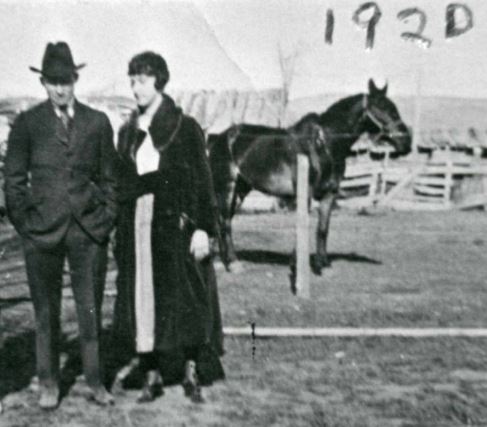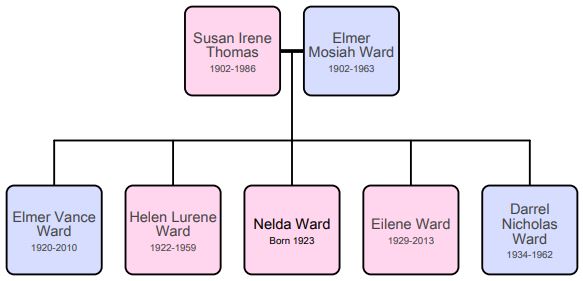Elmer Mosiah Ward


Elmer Mosiah Ward and Susan Irene Thomas
Elmer Mosiah Ward was born 22 Sept 1901 in Woodruff, Idaho, in the Malad Valley. His parents were Arbon homesteaders Jesse Nicholas Ward and Julia Ann Moon Ward. He was the fourth child, of eventually seven children in the family. He spent his summers growing up and working in Arbon Valley.
He married Susan Irene Thomas in Malad, Oneida, Idaho on 17 March 1920. Susan had been born 8 November 1902 in Malad, the daughter of David R. Thomas and Phoebe Ann John Thomas, who were some of the earliest residents of the Malad Valley. Susan’s father David was the first white child born in Malad, in 1864. Both Elmer and Susan attended school in Malad, and since they were only a few months apart in age, they probably knew each other most of their lives.
Their marriage produced five children: Elmer Vance Ward, 1920-2010; Helen, 1922-1959; Nelda Ward Williams, 1923; Eileen Ward Estep, 1928-2013; and Darrel Nicholas Ward, 1934-1962. Of these five children, Elmer, Nelda, and Eileen all stayed and raised their families in Arbon Valley.
After their marriage, Elmer and Susan moved out to Arbon shortly afterwards. They traveled in a wagon pulled by a team of horses. That started a family tradition of moving to Arbon in March and returning to Malad in November. After the children were of school age, Susan came out later and left earlier to accommodate the school year. They traveled by team and wagon like this for six years until the family bought their first motorized vehicle in 1926, which was a Chevy truck. This made travel back and forth to town a lot easier.
They were the second residents of the two-story log cabin home build by Elmer’s father Jesse Ward. This was on the original homestead, and wasn’t moved to its present location until 1949.
Elmer took over the family ranch around 1920, consisting of 320 acres of the original Jesse Ward homestead. Over the years Elmer purchased additional acres, and then in 1939 he bought the Jerry Baker farm, which had the added benefit of providing a larger home for the family. This is where the Ward farm headquarters are now, and where the Jesse Ward cabin was moved to in 1949.
The children remember that their parents were hard workers – indeed, it was hard to “make it†in Arbon Valley if a man and his wife weren’t hard workers. Elmer and Susan kept the children involved in the work of the farm. Their daughter Eileen stated: “Mother would take out Dad’s lunch to him and she would drive the team to farm while Dad ate his lunch. We all knew the meaning of work including the girls, from milking cows, driving tractor, running header on the combine, riding the derrick horse, pulling the pesky rye. Of course, there was always water and wood to haul and the separator to turn†(Bannock Valley, page 86).
One of the Wards’ good neighbors was a widow lady named Rosie Phelps who lived only a mile south. The two families did a lot together, from picnics and chokecherry picking and other outings. Daughter Eileen related a time her mother Susan and friend Rosie went on a trip to Malad and decided to buy material and sew matching dresses. “They really splurged. They each bought three yards of rose-colored material for five cents a yard and a quarter yard of white material for the collar and cuffs. Each one made a dress [just] alike for a little over fifteen cents. They made a butterfly type dress, [and] made their own pattern up†(p. 86).
For the Arbon families, being self-sustaining was important since the closest stores were several hours away. “Mother and Dad were very self-sustaining. They would stock up on enough groceries to last the whole summer. I don’t remember a time they ever had to go to the grocery store to prepare a meal. They always had their own milk cows, raised pigs, chickens, turkeys and had bum (orphaned) lambs. They always had these to move back and forth to Malad. Dad did his own butchering of all these animals. He would cure his own pork, make head cheese and link sausages. Mother used to do lots of canning and drying foods. She used to make pickles and store them in crocks. She would also store the preserves in large crocks†(87).
“They raised a large garden. They had a long row of gooseberries. We would all pick them…Dad didn’t believe in anything going to waste, so when we’d get all we could use, we’d pick some to take to Grandma Ward and relatives in Malad. Mother would make delicious gooseberry pies, canned gooseberry and preserves. [She] also made lots of rhubarb pies, chokecherry jelly, etc.â€
“They raised fifty turkeys one year and cleaned them and sold them to the story. Mother always had sitting hens with little chickens. We always had milk cows and we’d separate the milk with a hand turned separator. We had lots of fresh cream for cooking and butter we churned. Down at the Jerry Baker farm we had an ice house where they would store blocks of ice in sawdust way into the summer. We always had lots of homemade ice cream turned with the hand crank freezer.â€
“They used the barrel from the windmill for a refrigerator. They would store the food and milk in bottles and tie a string around the top and lower it down into the ice-cold water and tie a string around top of the barrel. You could even set jello, [and] left-over creamed peas and potatoes kept well…The grandparents in earlier years would lower the bottles directly into the well water before they had a wooden barrel. In later years the folks purchased a coal-oil refrigerator.â€
“They used to keep their cured hams and bacon buried in the wheat to keep [them] cool. Another way [to preserve meat] was to partially cook the pork and cover [it] with fat and store [it] in crocks. Mother would [also] can some pork and make delicious pies.â€
Even though this 2nd generation in the Arbon Valley had it easier than their homesteading parents, things were still challenges when people look back on it. Daughter Eileen stated, “Wash days [were different] than nowadays. They’d have the water to haul from the barrel, then heat it on a boiler on the coal stove. For many years [Susan] used the scrub board, then they had the old hand crank washing machine. She always used to boil the whites to whiten them… [and] everyone always made their [own] homemade soap. The Saturday night bath was kind of like wash day. [There was] the water to haul and heat and get out the old round tub. We’d usually have a sheet for a little privacy.†Before electricity was in the valley, they used coal oil lamps and would sit around the kitchen tables in the evenings, reading.
It is always out of order when children die before their parents, and sadly, Elmer and Susan experienced the deaths of two of their children. Their daughter Helen died in 1959 when she was only thirty-seven. Then, just a few years later, their youngest son Darrel died in January 1962, after it was discovered that he had a congenital heart problem that needed to be corrected by surgery. However, he died during the surgery to fix his aorta when he was just twenty-seven.
Elmer loved to dance, but never learned how until he was in his late forties. He took lessons from the Arthur Murray dance studio and didn’t tell his family. The secret came out when a granddaughter witnessed him holding a book in his hand and practicing dance steps out in a farm field. After that there was no stopping him. He and Susan enjoyed dancing with the young people when they would hold dances at the local schools.
Elmer and Susan also started going on trips with Arbon neighbors. They also went on a short-term mission for the Church of Jesus Christ of Latter-day Saints in Alexandria, Louisiana in 1954 when their son Darrel was on his church mission in Florida.
Elmer was enjoying life to the fullest when he unexpectedly had a heart attack and passed away while he was on a hunting trip with his neighbor and friend, Andy King. He had just turned sixty-one, so this was quite a shock. He was buried in Malad. Susan lived another twenty-three years, passing away on 8 October 1986 in Malad. She, like her parents, husband, son, and daughter, was buried in Malad.
Elmer’s son Elmer Vance (1920-2010) took over the farm/ranch operation that included the original homestead. Elmer’s sons Vance and Darrel now farm the land with their grown children and grandchildren.
Other connections were made in the valley, as Elmer Mosiah’s daughter Eileen married Louie Estep, an Arbon farmer, and his daughter Nelda married Sod Williams, an Arbon rancher and horseman who started out working for Joe Arbon. Today the fifth generation of Wards and Williams continue farming and ranching in Arbon Valley.
Sources:
Ward, Laurie Jean, Bannock Valley (Providence, Utah: Keith Watkins and Sons, 1982).
https://www.familysearch.org/tree/person/details/KW8C-7HV
https://www.findagrave.com/memorial/81204940
The links provided here will lead to information on other family members.
